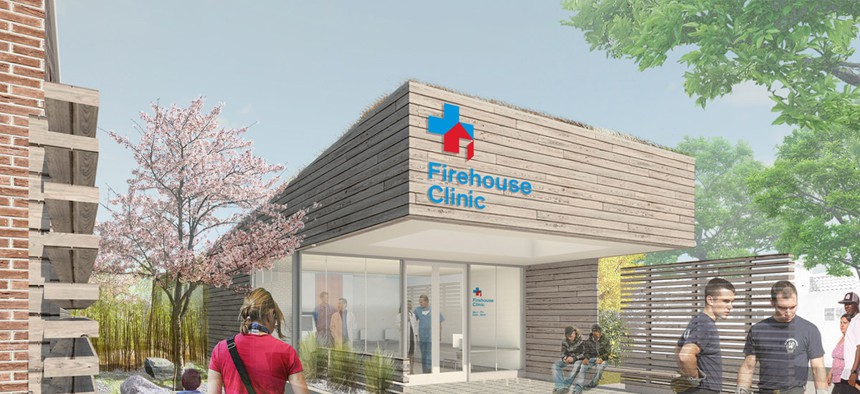A Great Place to Put Community Health Clinics: Fire Stations

WRNS Studio

Connecting state and local government leaders
A new firehouse clinic in California shows how an abundant but under-used public resource—fire stations—can be made even more useful for a community.
City officials in Hayward, California, broke ground this month on a new fire station that includes a first in community design for the city, the county, the state, and maybe even the nation: a built-in health clinic.
It's a novel idea that Alameda County officials have been kicking around for a while now. And it's one that makes a lot of sense for cities beyond Hayward, according to an architect who drafted a set of design guidelines to explain how a so-called Firehouse Clinic should work.
"Essentially the idea is that fire stations, and fire fighters, are a trusted entity in the neighborhood," says Kyle Elliott, partner at WRNS Studio in San Francisco. The architecture firm designed a mock Firehouse Clinic, pro bono, in an effort to generate enthusiasm for the concept. "There's an EMT on site, typically, in a fire house. It makes a good symbiotic relationship to place a clinic adjacent to a fire house."
In Hayward, the new community health clinic will be co-located on the grounds of the new fire station, which services the Tennyson Corridor, a community with a large population of low-income and uninsured or indigent individuals and families. The Hayward clinic aims to persuade people with limited healthcare access to choose the Firehouse Clinic over the emergency room, especially for preventative care.

To do so, the Firehouse Clinic will keep longer hours (8 a.m.–8 p.m. on weekdays) and guarantee appointment times within 72 hours of a patient's request. The building, which will be separate from the fire station, will be a 2,400-square-foot, 7–exam room facility. The Alameda County Health Care Services Agency expects 5,000 new patients to be seen at the clinic during its first two years.
"Our job was to crystallize a vision, not the vision, and to articulate the guidelines and principles to think about," Elliott says. "There were discussions about investigating something added onto an existing building, or reusing a part of an existing building. Those are very plausible solutions for communities."The design by WRNS for a Firehouse Clinic assumed a fire station with an available parcel adjacent to the building, since several of the fire stations being considered by Alameda County for the clinic fit that billing. (WRNS Studio designed the mock prototype in partnership with Public Architecture , an organization that works with design firms to solve social problems.) Fire stations in many cities aren't long on land, of course. That doesn't necessarily exclude them from consideration for the next Firehouse Clinic.
The WRNS design guidelines —which Public Architecture published on a new website, firehouseclinic.net , with input from six different California healthcare and emergency organizations—suggest ways that landscaping, natural light, and even the form of the building can engender trust in communities that don't have reliable access to healthcare.
The real genius of the idea, of course, is that fire stations are generally under-used facilities (in the sense that firefighters are either waiting around or out doing their jobs), and every city's got at least one. South Hayward lacks a dedicated adult public health clinic, but the city has a fire station. Now it has both. This is an idea that deserves to catch on.




